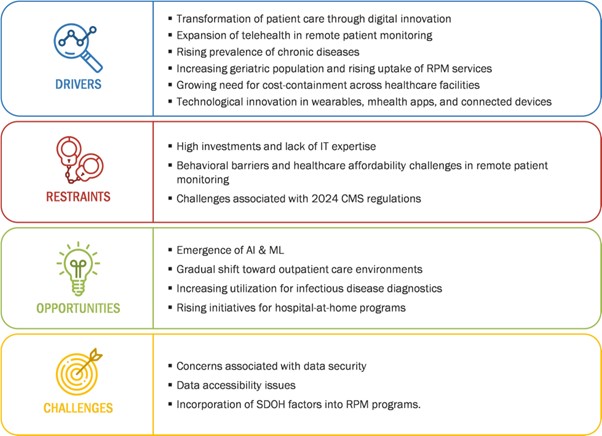What Sponsors Should Know About The Remote Patient Monitoring (RPM) Market
By Tushar Genji, assistant manager, MarketsandMarket

The remote patient monitoring (RPM) market involves the use of technology to remotely monitor and manage patients' health conditions outside of traditional healthcare settings as well as in patient settings. It leverages devices, such as wearables, sensors, and mobile applications, to track vital signs and chronic diseases.
The Uses and Benefits Of RPM
Remote patient monitoring solutions are emerging as powerful tools to enhance patient outcomes and reduce healthcare costs, but they are also increasingly used in clinical research. Pharmaceutical and biotechnology companies leverage RPM technologies to streamline drug development processes, enhance clinical trial participation, and improve patient engagement. Specifically, RPM enables companies to collect real-time data on patient responses to new treatments and adjust protocols as needed, thereby accelerating the drug development life cycle. Furthermore, the rise of virtual consultations and telemedicine platforms enables pharmaceutical firms to conduct clinical trials more efficiently, doing so in real time and reaching a larger pool of patients without geographical limitations. This has proved especially valuable in rare disease trials, where patient populations may be spread across vast distances.
Pharmaceutical companies are also using RPM to enhance patient adherence to medications. Through RPM devices, companies can remind patients about prescription refills, track medication usage through connected devices, and offer virtual consultations to address any concerns about side effects or treatment progress. This improves patient compliance, which is critical to the success of clinical trials.
Moreover, pharmaceutical and biotechnology firms are adopting RPM solutions to expand their market presence and strengthen relationships with healthcare providers. Virtual platforms allow companies to offer medical education, provide access to specialists, and offer faster access to innovative therapies. As RPM tools integrate with electronic health records (EHR) and data analytics, pharmaceutical companies can further personalize treatments, enhancing the precision of their offerings.
Understanding RPM Market Growth
The remote patient monitoring market is expected to grow from $27.72 billion in 2024 to $56.94 billion by 2030, at a CAGR of 12.7% during the forecast period, according to MarketsandMarkets. Key growth drivers include the growing aging population, which requires continuous monitoring for chronic conditions, and the increasing shift toward value-based care models. The rising focus on personalized healthcare and growing regulatory support for telehealth services are further propelling market growth.
However, varying regulations across regions could challenge market growth, necessitating careful attention to ensure the widespread adoption of these technologies. In 2023, North America accounted for the largest share of the remote patient monitoring market, with 53.4%. North America’s large share can be attributed to its robust healthcare infrastructure, high healthcare expenditure, and widespread adoption of digital health technologies. However, the Asia Pacific market is expected to register the highest CAGR during the forecast period, at 15.6%. Factors such as the increasing adoption of smartphones, growing healthcare awareness, and the rising incidence of chronic diseases are driving this growth. Additionally, government initiatives promoting telemedicine and digital health solutions and expanding telecommunication infrastructure are boosting RPM adoption. The growing aging population and demand for affordable healthcare solutions also contribute significantly.
Remote Patient Monitoring Market: Drivers, Restraints, Opportunities, And Challenges

Drivers: The expansion of the RPM market is driven by transforming patient care through digital innovation. The increasing adoption of telehealth in RPM, coupled with the rising prevalence of chronic diseases, particularly among the growing geriatric population, significantly boosts the demand for these services. Additionally, there is an increasing need for cost-containment within healthcare facilities, driving the integration of RPM solutions. Technological advancements in wearables, mobile health (mHealth) apps, and connected devices further support the rapid growth and accessibility of RPM services, enabling real-time patient monitoring and improving overall healthcare outcomes.
Restraints: Despite the promising growth, pharmaceutical companies should be aware that the RPM market faces several restraints, including high initial investments and a shortage of IT expertise. Behavioral barriers and healthcare affordability challenges also hinder the widespread adoption of RPM, particularly in underserved regions. The complexities surrounding the Centers for Medicare & Medicaid Services (CMS) 2024 regulations pose challenges to stakeholders in the healthcare ecosystem.
Opportunities: However, opportunities are emerging, such as incorporating Al/ML, the growing shift toward outpatient care environments, and the potential utilization of RPM in diagnosing infectious diseases. Initiatives for hospital-at-home programs further enhance the scope for RPM adoption.
Challenges: Key challenges remain in data security, accessibility, and the integration of social determinants of health (SDOH) factors into RPM programs. All these need to be addressed for sustained growth.
Notable Areas Of Growth For Pharma
The growing focus on preventive care and patient engagement is encouraging adoption of RPM by pharmaceutical companies. The device segment accounted for the largest share of the RPM market in 2023, with 71.4%. The large share of the devices segment can be attributed to the increasing demand for wearable health devices, advancements in sensor technology, and the rising prevalence of chronic diseases. Integrating Al and ML into devices enables real-time health data analysis, improving patient outcomes. Additionally, the growing adoption of smartphones and mobile health apps enhances device connectivity and user engagement. Cost-effective production and improved battery life of devices further contribute to market expansion.
What Pharma Can Do Next
The RPM market is expanding, driven by technological innovation, the prevalence of chronic diseases, and a global shift toward value-based, patient-centric care. RPM technologies are not only transforming patient outcomes and reducing healthcare costs, but they are also redefining how pharmaceutical companies conduct clinical trials, accelerate drug development, and engage patients in real time.
With the global RPM market projected to more than double by 2030 and particularly strong growth in Asia Pacific, pharmaceutical companies can leverage these tools for competitive advantage, improved patient adherence, and deeper market penetration. However, to fully capitalize on this potential, companies must proactively address regulatory complexities, data security, and integration challenges, while embracing AI, mobile health, and cloud-based solutions to maximize impact.
About The Author:
 Tushar Genji, assistant manager with MarketsandMarkets, has 8-plus years of experience creating revenue impact for clients’ businesses by providing actionable insights. In his current role, he specializes in market research and forecasting for the syndicate and consults on studies related to healthcare, life sciences, and healthcare IT, delivering insights into market entry, growth, and go-to-market strategy, as well as advising clients on digital strategy, road map, and competitive analysis.
Tushar Genji, assistant manager with MarketsandMarkets, has 8-plus years of experience creating revenue impact for clients’ businesses by providing actionable insights. In his current role, he specializes in market research and forecasting for the syndicate and consults on studies related to healthcare, life sciences, and healthcare IT, delivering insights into market entry, growth, and go-to-market strategy, as well as advising clients on digital strategy, road map, and competitive analysis.
